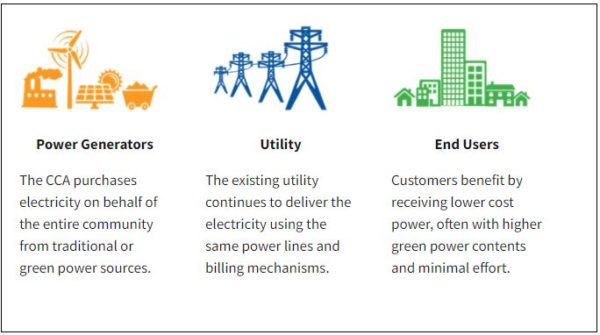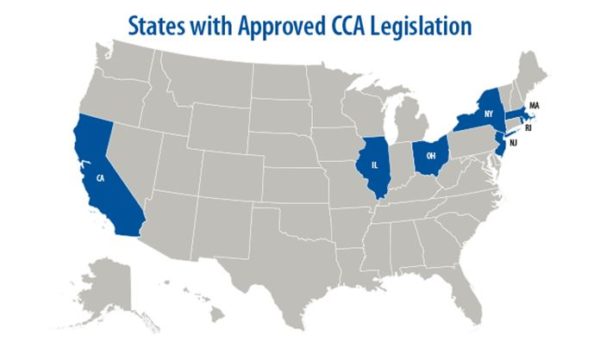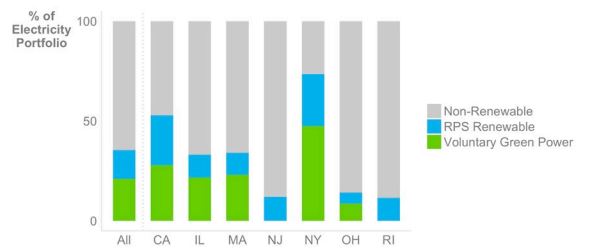Community choice aggregation (CCA), as defined by the U.S. Environmental Protection Agency (EPA), are programs that allow local governments to procure electric power on behalf of their residents, businesses, and municipal accounts from an alternative supplier while still receiving grid services from their utility.
CCAs help communities exercise control over their electricity sources, demand more green power, and negotiate lower electricity prices. Demand aggregation gives communities greater leverage when conducting these negotiations.
The first CCA legislation was passed in Massachusetts in 1997, and in 2016, over 8.7 billion kWh of clean power was delivered to about 3.3 million customers across the seven U.S. states that have approved its use, said the EPA
How do CCAs work?
To create CCA legislation, local governments must hold public hearings and then pass law that authorizes the CCA. Homes, businesses, and municipal sites in an approved jurisdiction may qualify, depending on the design of the CCA law.
 CCA participation is always voluntary. Most programs have opt-out provisions, so that when a community begins a program, customers are given advanced notice and have the choice to opt-out of the CCA and continue to receive electricity from their conventional supplier. Generally, customers who do not opt-out are automatically enrolled.
CCA participation is always voluntary. Most programs have opt-out provisions, so that when a community begins a program, customers are given advanced notice and have the choice to opt-out of the CCA and continue to receive electricity from their conventional supplier. Generally, customers who do not opt-out are automatically enrolled.
Many CCAs have a tiered structure. There is often a standard option that automatically enrolls customers, and an optional tier that has a higher (sometimes 100%) renewable energy supply, usually at a premium rate. The power is typically sourced from locally-sited renewable energy sources.
Electricity prices of CCA members are often 15-20% lower than residential retail prices for electricity, said EPA.
Pros and Cons
One advantage for customers is the ability to reduce their utility bill rates and opt-in for a higher proportion of renewable energy. Control of electricity generation is localized, which means municipalities can be more sensitive and responsive to local economic and environmental goals, said the EPA.
CCAs represent an expansion of consumer choices, and can spur local jobs, particularly in renewable energy development.
CCAs do, however, come with their set of issues. These programs require successful navigation of various regulations placed on CCAs, and appropriate ordinances must be passed for the programs to launch properly. This complexity can lead to higher administrative costs, which can place some burden on municipal budgets and bandwidth.
The opt-in and opt-out clauses can also be a cause of confusion for some consumers, said the EPA. Community solar programs or residential solar ownership or leases are often more easily understood by homeowners making energy decisions.

Image: EPA
How “green” are CCAs?
The Energy Department’s National Renewable Energy Laboratory (NREL) estimated that in 2017, CCAs procured about 8.9 million MWh of voluntary green power, representing 21% of CCA sales. While this is a far cry from the 100% renewable energy a home solar or community solar program can provide, the figure is nearly double the rate that the U.S. saw for renewable energy end consumption in 2017, which was 10.6%.
About 13% of CCAs offer voluntary green power. New Jersey and Rhode Island do not have voluntary green power options as their CCAs are primarily focused on leveraging lower energy prices.

Image: NREL
Roughly 9% of all nationwide voluntary green power sales in 2016 were attributed to CCA’s, said NREL. Colorado, Connecticut, New Hampshire, New Mexico, Nevada, Oregon, and Utah have all considered CCA legislation, and NREL estimates these states could open voluntary green power options to an additional 18 million Americans.
Challenges faced by CCA
NREL identified several key challenges to CCAs and their efficacy going forward. For one, maintaining cost savings in the long run may be difficult. Thus far, CCAs have largely been able to stay beneath utility prices, but they run the risk of opt-outs and lessened leverage if they cannot remain price-competitive.
There is also a balancing act that must be played between local autonomy and regional cooperation. Communities face tradeoffs in CCAs, where local aggregation of a single jurisdiction yields higher levels of autonomy over supply and rates, while aggregating across several jurisdictions can yield economies of scale and allow CCAs to offer more services. California has seen a rise in larger aggregation of jurisdictions, with joint power agreements being facilitated by state and national organizations.
For CCAs in restructured electricity markets, inability to sign long-term contracts poses a challenge to local renewable energy procurement. However, CCAs in restructured markets are exploring and implementing innovative ways to procure local renewables, such as through community solar and trust funds for local projects.
While a CCA does not provide the personal autonomy of solar ownership, it represents one more option at the disposal of homeowners and businesses to find alternative ways to source their energy.
This content is protected by copyright and may not be reused. If you want to cooperate with us and would like to reuse some of our content, please contact: editors@pv-magazine.com.









The two California CCAs that I have opted out of, serving Placer and Mendocino Counties, provide no significant or slightly negative differentials from PG&E rates. Which makes sense, since:
1) a large fraction of the total residential per-kWh cost is still collected by the Investor Owned Utility (IOU) to cover distribution and other grid costs, and
2) the CCA adds the overhead of a public agency administration and of its energy market consultants.
Apparently, some CCAs relied initially upon carbon offsets to “green-up” sources of their energy supply, in the absence of available wind and solar supplies.
The impact upon IOUs (PG&E in particular — already reeling financially from wildfire judgements) of cannibalizing their customer base might be a real concern. What rational, competent private or public entity would care to operate the Northern California grid should PG&E fail, in the face of dwindling sales volume over which to spread untold billions in future climate-driven wildfire damages?
On the other hand, electrification of ground transportation and space heating may so increase demand among the customers retained by IOUs as to offset CCA defections.
I’d like to correct the information in this article, there are 10 states in the US with CCA legislation, not 7.
I’d also like to add that the IOU and CCAs work in partnership – in California, a CCA procures energy, which has higher clean energy content than the IOU offers, at a competitive and often lower price. The IOU delivers the energy over their lines, and is responsible for maintaining power infrastructure and billing customers.
The IOUs are very generously compensated for their “departing load” via a Power Charge Indifference Adjustment, or PCIA. This fee is meant to cover utilities’ ongoing costs for legacy investments like power plants, and leave them no better or worse off than they would have been if they hadn’t lost the customers at all — hence the word “indifference.”